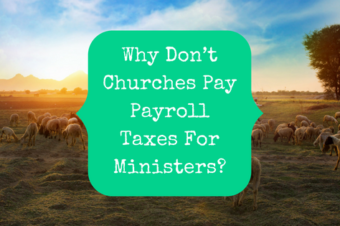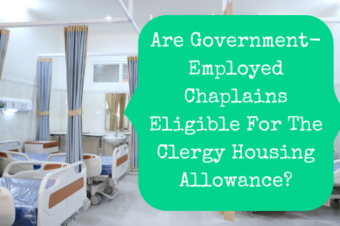Back in 2017, the president timed things just right so that I spent the first day of my family’s Christmas vacation researching the tax reform bill and how it affects pastors. Now, almost two years to the day, he signed into law another sweeping financial reform just in time for me to fly down to visit my family for Christmas. Thanks, Congress, I really appreciate your timing.
The Setting Every Community Up for Retirement Enhancement (SECURE) Act was signed into law on December 20, 2019, as part of a year-end appropriations bill to keep the government running. It makes significant changes to retirement plan rules that affect most Americans. Also included in the 1,770-page bill was the Taxpayer Certainty and Disaster Relief Act of 2019, which could affect how you file your tax return in the coming months. While there are no changes to the laws as they relate to pastors specifically, there are a number of other changes that might affect you.
Changes That Affect Your 2019 Taxes
Tuition And Fees Deduction
The above-the-line deduction for tuition and fees that had expired has been reinstated for 2019 and 2020. Up to $4,000 of qualified tuition and fees can be deducted. For 2019, you will need to choose between taking the deduction and the American Opportunity Credit or Lifetime Learning Credit.
Mortgage Insurance Premium Deduction
Mortgage insurance premiums may once again be included as an itemized deduction for 2019 and 2020. If your mortgage bank requires insurance on your loan and the loan qualifies, you can include it on Schedule A.
Medical Expense Deduction Threshold
The percentage of your income that medical expenses have to exceed to be deductible was supposed to increase to 10%, but that has changed. The threshold will remain at 7.5% for 2019 and 2020. Any expenses above 7.5% of adjusted gross income can be deducted.
Mortgage Forgiveness
Usually, when a debt is forgiven, the amount forgiven is counted as income and you have to pay taxes on it. The new law makes it so that qualified primary residence indebtedness that is forgiven can be excluded from income so that no taxes will be due on it.
Federally Declared Disaster Areas
Taxpayers living in federally declared disaster areas have been allowed to take penalty-free money out of their retirement accounts for 2018 and 2019. In addition, the new law gives taxpayers living in those areas an automatic 60-day filing extension. This applies to all current and future disaster areas.
Changes That Affect Retirement Accounts
Traditional IRA Contribution Age Limit
Starting in the 2020 tax year, there is no longer an age limit for traditional IRA contributions. Previously, you had to stop making contributions at age 70 ½. Now, you can continue making contributions as long as you have earned income, regardless of your age. You still cannot make contributions for 2019 if you are over 70 ½.
Graduate & Post-Doctoral Student IRA Contributions
Previously, graduate and post-doctoral students could receive taxable stipends and non-tuition fellowships that were included in gross income but didn’t count to allow them to contribute to an IRA. (You or your spouse must have income to be able to contribute to an IRA.) Thanks to the SECURE Act, that taxable income now makes them eligible to contribute to an IRA.
Required Minimum Distributions
Up until December 31, 2019, once a person turned 70 ½ they were required to start taking withdrawals from their retirement accounts (except for Roth IRAs). These are called required minimum distributions (RMDs) and a 50% penalty is imposed on any amounts not withdrawn in time.
The new law changes the age at which RMDs must be taken to 72. It only applies to those turning 70 ½ after December 31, 2019, though. If you turned 70 ½ before then, you must start taking withdrawals already.
Birth And Adoption Withdrawals
You can now take up to $5,000 out of your IRA to cover qualified birth and adoption expenses penalty-free. The distribution must be made after the actual birth of the child or the adoption is finalized. However, you can use it to pay yourself back for your initial adoption expenses or money you spent preparing for your new child.
The $5,000 is a per-person, per-child limit. That means that both parents are eligible to take $5,000 withdrawals and they can take them for each of their children. There is also a provision in the law where you can repay your retirement account the amount that you removed in relation to a birth or adoption, but regulations have not yet been issued to clarify how or when that must be done.
Inherited Retirement Account Distributions
Previously, when someone inherited an IRA or another retirement account, they were required to start taking distributions calculated so that they would last over the heir’s lifetime. Many people with money to spare would leave their retirement accounts to grandchildren because of this so that the money could continue to grow over the 60-80 year life of the youth.
Under the new law, those inherited retirement accounts must be emptied within 10 years (though there is no requirement for how much must be taken each year). The only exceptions are spouses, disabled individuals, and individuals not more than 10 years younger than the account owner, who can still stretch out the distributions for their lifetime. Minor children of the original account owner have a special exception, but only until they reach the age of majority, at which point they have to empty the account within 10 years.
Changes That Affect Educational Savings
529 Plan Usage
The new law allows up to $10,000 from a 529 plan to be used to pay down student debt without taxes or penalties. This is a per-person limit and in addition to the 529 plan beneficiary, the siblings (of any age) of the beneficiary are also eligible for up to $10,000 to pay down their loans. Also, apprenticeship programs have been added to the list of institutions where 529 plan funds can be used, as long as they are registered with the Department of Labor. This part of the law is effective January 1, 2019, so you can use it retroactively for expenses incurred last year.
In earlier versions of the SECURE Act, there was a provision to allow 529 plan funds to pay for homeschooling expenses. However, that did not make it into the final version of the bill which has become law.
There are a number of other provisions in this law that became effective January 1, 2020, but most of them do not relate to you as an individual. The above changes are the most important parts of the law as they affect individual taxpayers.






























